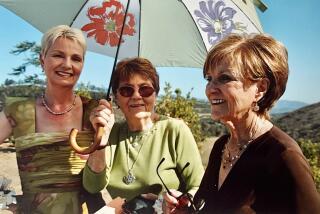Norwegian Emigrants Invited to Trace Roots
- Share via
LILLEHAMMER, Norway — If you’d like to spend Midsummer’s Eve in an old Nordic village, glide across an ice-blue lake in a paddle-wheel steamer, study old handcrafts or meet a tricky troll, it could be time to investigate your Norwegian roots.
Norway is planning a summer celebration to help its emigrants and their descendants rediscover their homeland and trace their ancestry. From June 1 to Aug. 31 the town of Lillehammer will stage a Norwegian Roots Festival, with music, history, art, handcrafts and genealogy.
All summer long, weekly programs will feature lectures and guided tours of historical and artistic interest. Mondays will feature Malerisamlingen (art gallery by the marketplace), with its collection of 19th-Century and modern Norwegian paintings. On Tuesdays there will be a tour of the Museum of Historical Vehicles; Wednesdays, Maihaugen; Thursdays, the Art Museum, and Fridays, a search for the legendary trolls at Hunderfossen.
Island in Time
In any country of the world, Maihaugen and the museum would rank as something special. A century ago Anders Sandvig began collecting old Gudbrandsal rural buildings and workshops.
Today a charming village with more than 100 old buildings, gardens, churchyard, lakes and streams occupies a hill overlooking Lillehammer, truly an island in time. Carved wooden furniture, farm implements, kitchen utensils, lace curtains make it seems as if the residents might reappear at any time.
Maihaugen’s young guides, in Norwegian costume, are part of the fun. A school in Lillehammer offers a major in tourism, and these guides are student interns, friendly, exuberant and anxious to practice their English skills.
Anyone interested in folklore or crafts can happily lose themselves for hours in the museum adjoining Maihaugen. In it 60 old workshops have been re-created in loving detail. There are shops of weavers, glaziers, printers, hatmakers, blacksmiths, lace makers, silversmiths, bookbinders, gunsmiths, sleigh makers and many other trades. For those who wish to linger, Maihaugen has a pleasant, not-too-expensive cafeteria.
The week of June 29 to July 4 will feature festival highlights. There will be daily concerts of Norwegian music, folk dancing, displays of old handicrafts and traditional Norwegian cooking, a Bunad Parade of national costumes and entertainment and, for the climax, an Independence Day celebration.
Other events of appeal to visitors will be a Mid-Summer’s Eve (June 24) at Maihaugen, with handicraft exhibitions, an antique car race, excursions, church services in English and the Lillehammer Trade Fair.
Those of Norwegian descent will have an opportunity to trace their roots. There will be a special collection of genealogical information and experts to assist. Another item of interest to them will be an exhibition of photos from the major emigration period that began 100 years ago. Perhaps there will be a picture of great-uncle Oskar.
Valley and Mountains
Lillehammer (population 22,000) is easily accessible from Oslo, 100 miles south, via well-traveled highway E6 and Norwegian State Railways. It is the heart of Gudbrandsdalen, a large and fertile valley leading to craggy mountains, and sits at the tip of Norway’s largest lake, Mjosa.
Gudbrandsdalen has roots of its own, back to the time of the great Viking chieftain Dale-Gudbrand, and Saint Olaf. Its artistic heritage boasts of Nobel Prize-winning authors Bjornstjerne Bjornson and Sigrid Undset. Henrik Ibsen was inspired here to write his famous “Peer Gynt,” and Edvard Grieg composed some of his music.
Lillehammer is a sports center. Although famous for winter skiing and ice skating, it has much to offer the active summer visitor: windsurfing, riding, boating, water skiing, biking, fishing and hiking. On your hikes you may discover mountain cabins 1,000 years old. If all that sounds a little too strenuous, relax and take a ride on Lake Mjosa on Skibladner, the historic paddle steamer.
The Norwegian Tourist Board can supply a list of tourist accommodations in Lillehammer including hotels, pensions, apartments and camping chalets. Throughout the valley are 100 well-equipped camping sites with small cottages for privacy and weather protection.
The area also has fjellsltues, or mountain chalets, catering to winter sports, that are quite inexpensive in summer. A real adventure might be a farm holiday, especially attractive to families with children. These can be arranged through the Norwegian Roots Festival office.
Prices in Norway are high, even with a relatively strong dollar, but Lillehammer is less expensive than Oslo or Bergen. Be prepared to pay $60 to $80 in a first-class tourist hotel for a double room with bath. Breakfast is often included. A pension without private bath would be less than half that.
One of the nicest bonuses of travel in Norway is the friendliness of the people you meet, most of whom have relatives, however distant, in the United States or Canada. If you trouble yourself to learn even a few Norwegian phrases, you will be greeted with warm smiles, cries of “Norsk-Americaner?” and questions about your connections and theirs.
Most tourists in Norway see only Oslo, Bergen, the fiords. This summer you could find your roots in Lillehammer.
For more information: Norwegian Roots, P.O. Box 181, N-2601 Lillehammer, Norway. Norwegian Tourist Board, 655 3rd Ave., New York 10017.
More to Read
Sign up for The Wild
We’ll help you find the best places to hike, bike and run, as well as the perfect silent spots for meditation and yoga.
You may occasionally receive promotional content from the Los Angeles Times.






